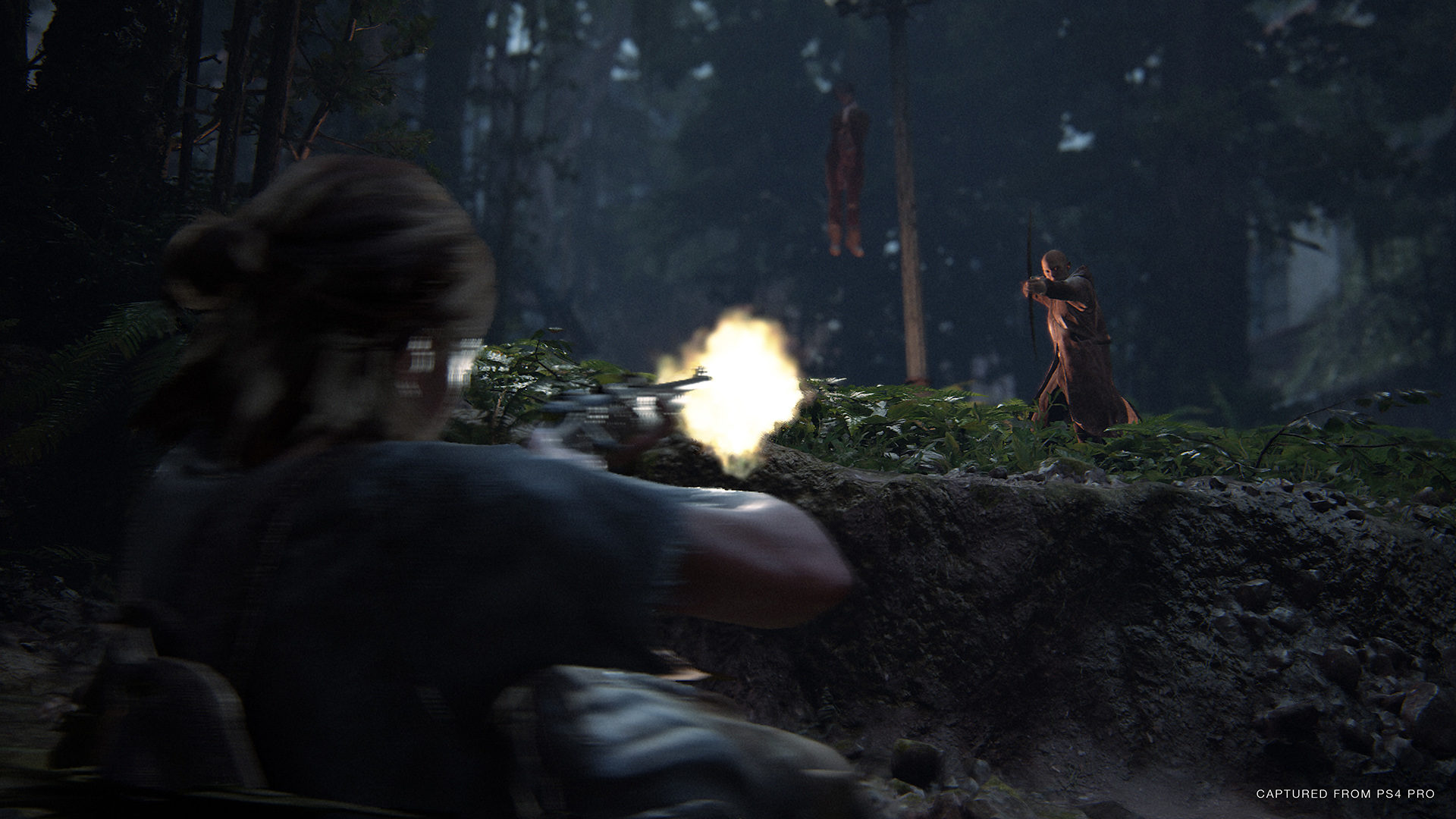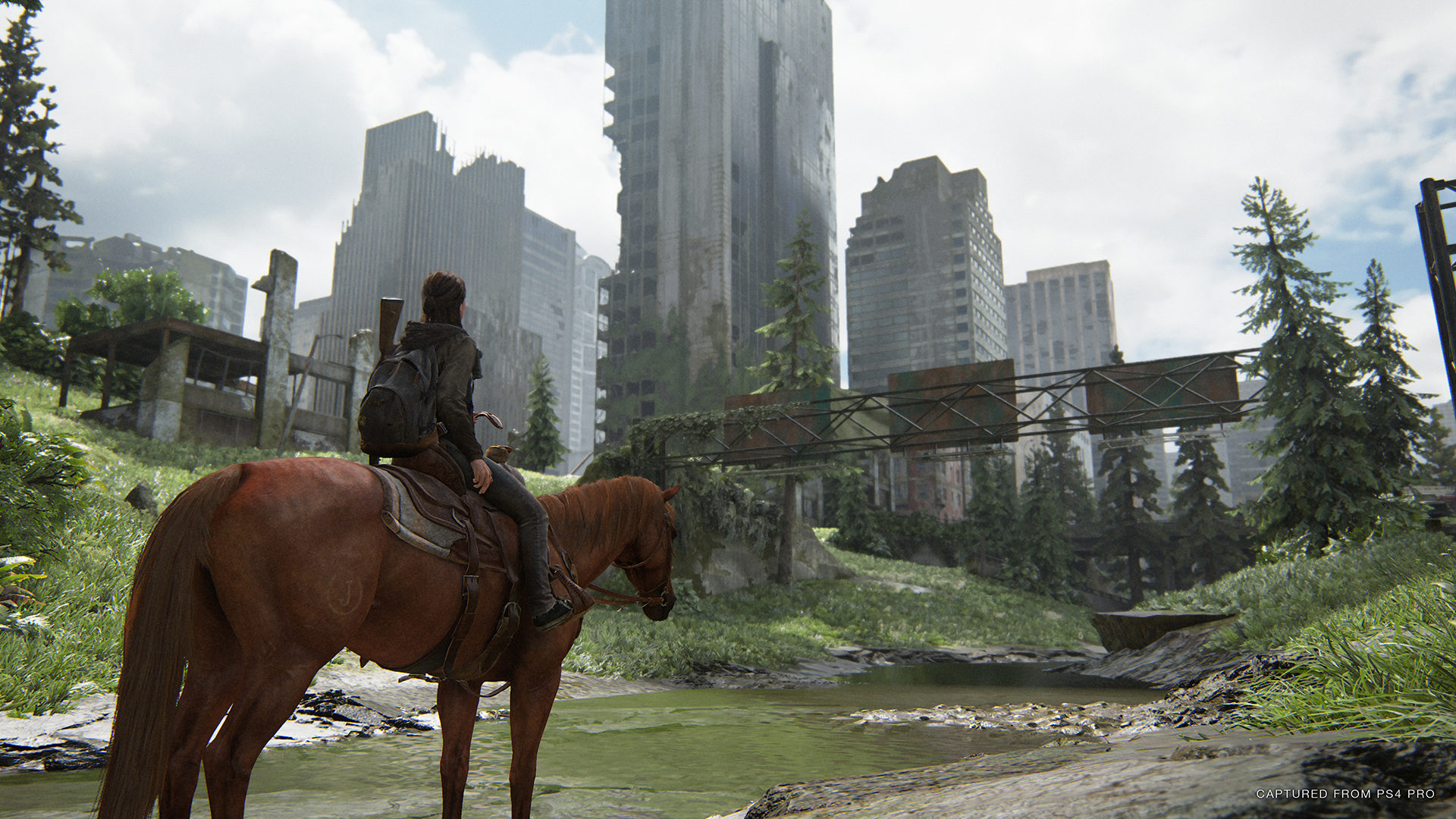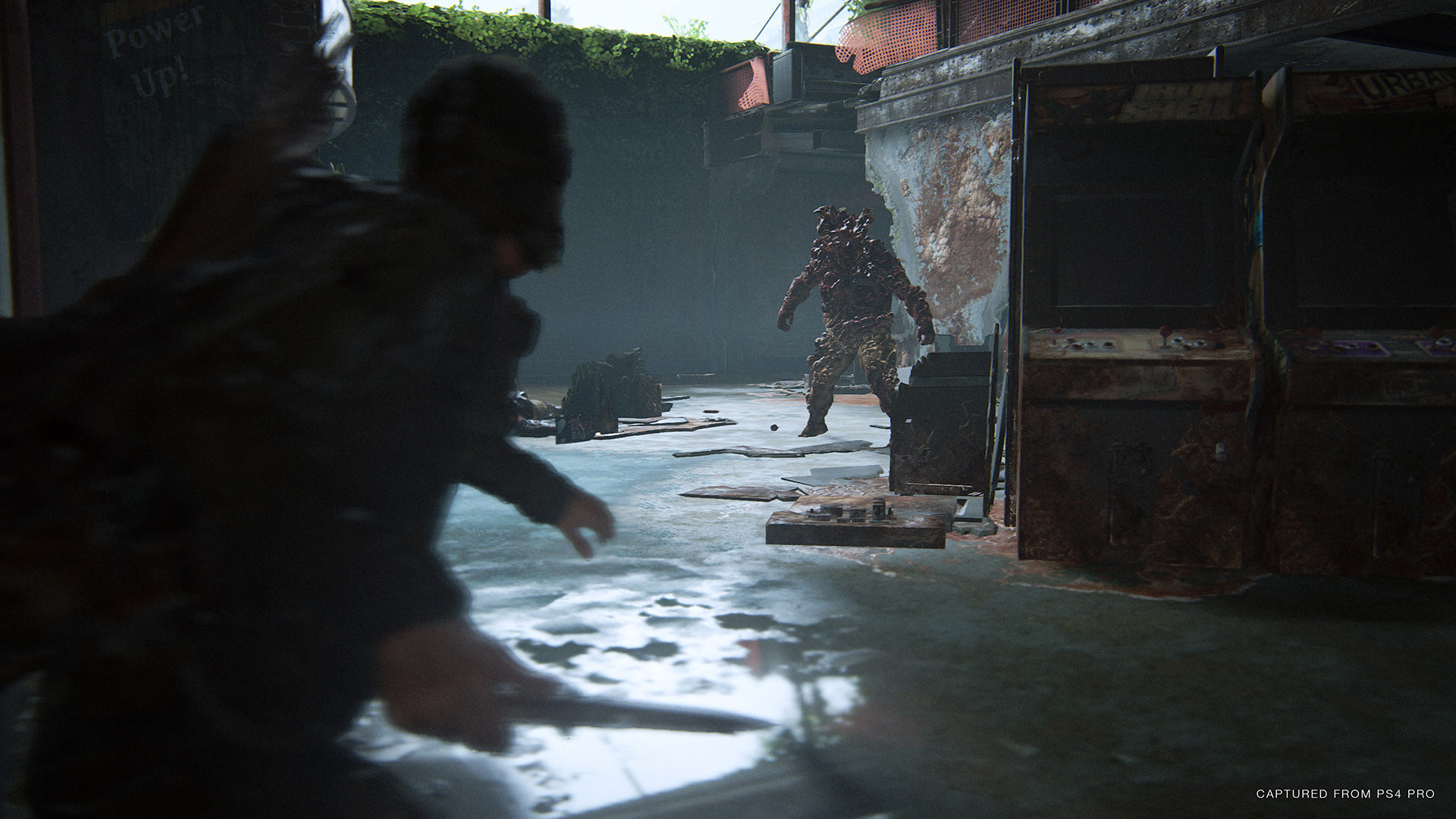If you came here to find out whether The Last of Us Part II is worth playing, that’s easy: Hell yes. But if you want to know whether Part II is a truly worthy successor to The Last of Us—whether this was a story that needed to be told—that’s a more difficult question to answer.
Let’s get the simple part out of the way: Naughty Dog has developed a truly stunning capstone to this console generation, a technical and design marvel that manages to improve upon every aspect of gameplay in the 2013 original. In many ways, it’s the same formula polished, expanded, and streamlined to reach its full potential. This feels like the game the developers always wanted to make.
You’ll still explore lush, post-apocalyptic environments, scavenging for supplies and solving naturalistic puzzles, but the sites are even more stunning, and the ways you can interact with the world are greatly expanded. You’ll still lug around a few ladders and drag a few dumpsters, but a more diverse set of options means you rarely feel like you’re solving the same puzzle twice.
And as for the stealthy combat—against both human survivors and the game’s fungal zombies, most memorably realized in the blind, mushroom-headed Clickers? As a longtime fan of stealth-heavy games, I can safely say that The Last of Us Part II’s encounters are almost magically good. Sure, if you’re patient and lucky, you’ll be able to take out every foe in a given arena without ever taking damage. But it’s much more likely that, at some point, your plan will fall apart and you’ll be forced to adapt, traversing the larger, more intricately interconnected environments to reposition and gain the advantage, carefully managing your scarce resources and ammunition to become a smart, lethal predator. Going prone in tall grass to stay hidden—at least until anyone gets close enough to spot you—is a particularly strong addition, leading to tense moments of lying in wait.

Credit: Sony Interactive Entertainment
I don’t think I’ve ever played a game this grounded in a semblance of reality that allowed for such dynamic, cinematic encounters. When the fights are good, they’re so good. One such example: I sneak up behind an enemy, grabbing him from behind. I use my silenced pistol to take out another enemy with his back to me, and then start stealth killing my hostage. But I take too long, and another soldier walks in and sees me, calling out my position before blasting me with a shotgun and sprawling me on my back. Still supine, I pull out a bow and arrow and shoot him in the throat before rising to my feet. I spot the last surviving enemy and sprint towards her, chucking a brick without breaking stride. She’s stunned, so I close the distance and finish her with my switchblade. You know when you’re watching a demo for a game before it’s out, and you feel like the action you’re seeing is so good it has to be scripted, or faked, or played under the most ideal possible circumstances? Moments like that happen all the time in The Last of Us Part II.
But that brings us back to that thornier second question.
The story of The Last of Us still looms large in our collective imagination for a reason. For my money, it’s the best story ever told in video game form (though perhaps not the story that best makes use of games as a medium). But even if you don’t share my enthusiasm, it’s difficult to deny that The Last of Us was a game that was built from the ground up as a means to tell its central story, of a smuggler named Joel and a girl named Ellie he’s tasked with transporting halfway across the U.S. Ellie, having discovered she’s immune to the fungal infection that’s collapsed society, is our best hope for a cure, you see.
In case you haven’t played it, I won’t spoil the ending here (but you should really get on that, especially if you’re thinking about picking up Part II). But that finale, and especially the final scene, remains one of the few perfect moments in gaming. Writer and director Neil Druckmann has himself called it “sacred.” So as I started Part II I worried that any continuation of Joel and Ellie’s story would ruin the poignant note we left them on.

Credit: Sony Interactive Entertainment
I think, having now beaten the game several times, that my fears were both entirely justified and misaligned. The Last of Us Part II does indeed blow up that ending—how could it not?—but the manner in which it does so is both fascinating and unexpected, serving to give the characters involved even more depth.
As it turns out, the ending wasn’t the real issue. What keeps me from calling The Last of Us Part II an unequivocally worthy successor is the continuation of the story that spins out of that ending. The plot of this game—the bulk of which takes place after Joel and Ellie have spent a few years living in relative safety in Jackson, Wyoming—is an entirely logical and well-considered continuation of where we left our protagonists. But the story that follows, perhaps the story that had to follow, is something altogether more ordinary than the first chapter. Well-executed, yes, and often surprising, and punctuated with deeply affecting moments of humanity. But still ordinary.
Even now, I can’t think of any real parallel for the original The Last of Us among the games that came before it. This wasn’t the kind of story games had ever tried to tell, let alone one that they’d told so successfully, with such sophistication. If you forced me to find an analogue, sure, I might frame it as a grimdark Ico. But the particulars of its plot, structure, and characters set it apart, made it feel singular for its time.
The Last of Us Part II, by comparison, is so much easier to pin down. I’ll shy away from any plot specifics—Sony’s guidelines for what I can talk about are fairly strict, and you’re better off going in totally cold anyway. But I’m not tipping my hand much to say that Part II is a revenge story about the cost of revenge, another violent game that wants you to feel uncomfortable with the violence you enact. I could list half a dozen games, good and bad, that have explored similar ideas in the last decade and a half.

Credit: Sony Interactive Entertainment
It must be said that Part II represents, on some level, the apotheosis of that approach. Most kill-lots-but-regret-it games stop at making the violence grotesque. Naughty Dog does plenty of that—the studio’s technical wizardry means every exploded skull or buckshot-severed foot is unsettling to look at—but Part II goes further by making its violence sad. When you kill an enemy, the survivors will often call out the name of the person who died in a tiny moment of shock and grief. Kill a dog, and the owner reacts in despair. Kill the owner, and the dog will whimper. Sometimes the last surviving enemy in an encounter will beg you for mercy that you, as the player, cannot actually grant. Subtler, and much more effective, however, is the flash of sheer terror that comes across an enemy’s face when you grab them from behind. Even as they whisper threats to you, their eyes seem to confront their impending, inevitable death.
In other words, The Last of Us Part II wants you to believe, through its small flourishes and formal ambitions, that the people you’re killing all have just as much of an interior life as Ellie does. If she feels alive to us as players, then why shouldn’t the people whose lives she ends?
I’m unsure how to feel about that in 2020—in our collective 2020, of course, but also in my own. My grandmother died a few days before I started the game; I attended her funeral four days after I finished my first playthrough. The service was small, outdoors, socially distanced. I couldn’t touch my family, lest we unknowingly infect one another with the coronavirus, a pathogen that’s now killed nearly half a million people worldwide. As my fiancée and I drove home on Highway 101, we passed a group of protestors who had stopped southbound traffic, carrying signs to remind us that black lives matter, because a Minneapolis police officer had murdered George Floyd by pressing a knee to his neck for 8 minutes and 46 seconds.
What I’m getting at, I guess, is this: Death in the real world is always a tragedy, and it’s not wrong or misguided for a game that trades in quasi-realism to imbue the act of killing with sadness and horror. But I don’t know that encouraging, and sometimes forcing, the player to engage in hundreds of acts of violence while holding them back up to the player with some mirror of guilt is as novel or impactful as it was when Far Cry 2, BioShock, or Spec Ops: The Line started treading similar ground. Increasingly, it feels like the only story violent games that aspire to be taken seriously ever try to tell. I’m not sure the contrived powerlessness these kinds of stories require—either you participate in the Bad Thing or you stop playing—is the best or most honest way to speak to the humanity of your characters or to encourage players to reflect upon reality.
Mechanically, technically, and, yes, even narratively, The Last of Us Part II is a spectacular accomplishment. I doubt I will play anything better this year. A part of me seriously wonders if I’ve played anything better, ever. It speaks to the exceptional quality of the experience that all my complaints are either niggling—the plot relies a bit too heavily on coincidence, some points-of-no-return are poorly signposted, the save system is inexcusably clumsy for replaying chapters—or extremely high-level, almost philosophical disagreements.
But I can’t shake the sense, perhaps the irrational sense, that The Last of Us Part II is missing some of the focus that made its predecessor so special. The Last of Us marshaled all of Naughty Dog’s considerable abilities towards a straightforward narrative with a simple goal: to build up the relationship between its two central characters so convincingly that an unjustifiable act seemed just. In unpacking and inverting that idea across a much longer playtime, Part II becomes less about its relationships and more about their absences. It trades simplicity for a muddier, bloodier exploration of a more abstract message: that empathy is both most difficult and most necessary when things seem bleakest. The lesson is true and right, but it’s one the real world is teaching us with more nuance and urgency than the best game ever could.
Header image credit: Sony Interactive Entertainment
|
★★★★★
Whether or not you consider The Last of Us Part II to be a worthwhile continuation of Joel and Ellie’s story, there’s no doubt that Naughty Dog has crafted a sequel that’s every bit as ambitious and well-considered as the original, with quite possibly the best stealth-action gameplay realized to date. |
Developer Naughty Dog Publisher Sony ESRB M - Mature Release Date 06.19.20 |
| The Last of Us Part II is available on PlayStation 4. Primary version played was for PS4 Pro. Product was provided by Sony for the benefit of this coverage. EGM reviews on a scale of one to five stars. | |
